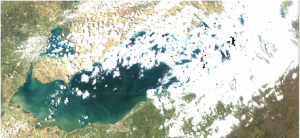Homepage Slider, Water Quality
Prediction for a smaller bloom in 2020
By Dusty Sonnenberg, CCA, Ohio Field Leader: a project of the Ohio Soybean Council and soybean checkoff
Just a few days prior to the Maumee River Watershed receiving several inches of rainfall, the Western Lake Erie Harmful Algal Bloom Early Season Prediction was released. The projection is a joint effort of the National Oceanic and Atmospheric Administrations (NOAA) along with the National Center for Water Quality Research at Heidelberg University.
It is projected that the 2020 bloom will be smaller than 2019. The models indicate a likely severity of 4 or less, however uncertainty in the projected forecast allows for the potential severity up to a 6 (on a scale of 1-10). The final level of severity in 2019 was a 7.5. The record highs were in 2011 with a 10, and 2015 with a 10.5.

The revised prediction released after the rainfall events still puts the likely severity between a 3 and 5.
The severity of the western Lake Erie cyanobacterial harmful algal bloom (HAB) depends on input of bioavailable phosphorus from the Maumee River during the loading season of March 1 – July 31. This gives an estimate of potential bloom severity based on a combination of measurements to date and forecasts of river discharge and phosphorus load from now into July.
The total bioavailable phosphorus load accumulated from the Maumee River near Waterville to date has matched those at the same time in 2016 and 2018. Both 2016 and 2018 were years that finished with a severity rating at or below 4.
“Prior to the recent rain events of the past week, the soil moisture was lower and there was water holding capacity available in the soils of the Maumee River watershed,” said Aaron Wilson, climate specialist with OSU Extension and Research Scientist at Byrd Polar and Climate Research Center.

“The rain the past few days will have an impact. There was room for water uptake, and the soils did absorb a lot, but now the water is running off and that will make an impact. Any additional heavy rains will cause a flush event.”
It is these “flush events” that cause increases in the P load measured in the river and lake.
“The weather outlook for June is for above slightly average temperatures (primarily at night) and average precipitation,” Wilson said. “In June, Ohio averages 1 inch of rainfall per week. This June and July are shaping up to be similar to the recent past with more frequent and heavier rain events.”
The P that causes the P load increase comes from a couple of sources, according to Chris Winslow, director for Ohio Sea Grant and Ohio State’s Stone Laboratory. A majority of the acres in the Maumee River Watershed were planted and spring fertilizer was applied prior to the recent rain events. Winslow refers to this P as current use phosphorus.
“This is real-time phosphorus. This phosphorus would come from fertilizer applied in the spring that is available to the plants and can get in the water right now,” Winslow said.

Another form of P load comes from what has been referred to as legacy phosphorus.
“This is the phosphorus that was already found in the lake or is held in the soils that have high phosphorus levels. This is phosphorus available to the algal bloom every year,” Winslow said.
Ohio soybean farmers, along with other commodity groups and agricultural organizations in the state, have invested millions of dollars in research aimed at determining the cause of the algal bloom, and finding potential management practices to functionally mitigate the problem. Farmers are working closely with universities, government agencies, and environmental groups to make changes to protect the water. Practices like cover crops, nutrient management plans, soil sampling and more are increasing every year, and farmers are applying less fertilizer than ever before.